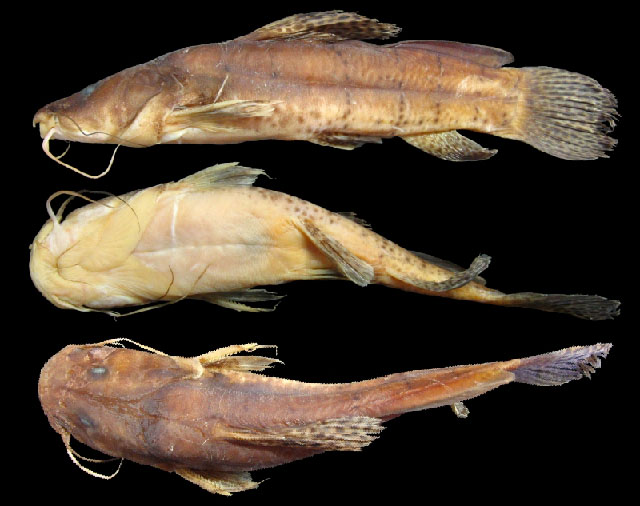| Auchenoglanididae (Flatnose catfishes) |
| 28.1 cm SL (male/unsexed) |
|
demersal; freshwater; pH range: 6.5 - 8; dH range: 4 - 25 |
| Africa: Lower Guinea river basins, from Sanaga River in Cameroon to Chiloango in Angola (Ref. 81642, 94168). Also in the northern half of the Congo River basin (Ref. 94168), including the Dja in Cameroon (Ref. 27938), Sangha in Congo Republic (Ref. 94168) and the middle Congo River basin in Democratic Republic of the Congo (Ref. 27938, 94168). |
|
Dorsal spines (total): 2-2; Dorsal soft rays (total): 7-8; Anal spines: 0-0; Anal soft rays: 10-12; Vertebrae: 38-38. Diagnosis: combined premaxillary tooth plate very broad, 33.5-41.7% of head length vs. 30.1-35.3% in N. boutchangai, and less than 30% in the other species; eye diameter large, 9.1-13.3% of head length vs. smaller in N. maculatum, N. pallidum and N. depierrei, but overlapping with eye size range of the other species; interorbital distance rather large, 28.0-36.6% of head length vs. 24.0% or less in N. akiri, N. depierrei, N. pallidum and N. pembetadi; only 7 soft dorsal-fin rays vs. more than 8 in N. depierrei, N. maculatum, N. pallidum, N. pembetadi, N. thomasi and N. walkeri; dorsal fin spine rather long, 6.9-14.7% of standard length vs. shorter in N. depierrei, N. maculatum, N. pembetadi and N. thomasi (Ref. 94168).
Description: body and head rather depressed, pre-dorsal body depth 16.1-18.0% of standard length, minimal caudal peduncle depth 13.2-15.9% of standard length, head depth 45.9-60.0% of head length; branchiostegal membranes each supported by 12 rays, almost not fused, separated by a deep medial slit, possibly overlapping; total number of 38 vertebrae; dorsal fin relatively high and rounded, spine 6.9-14.7% of standard length; 7 branched dorsal-fin rays; adipose fin moderately deep, 4.0-6.2% of standard length (Ref. 94168).
Colouration: dark brownish gray to pale yellow with numerous black or brown spots and blotches on the head, body and fins, often aligned in transverse bands along the flanks; juvenile colouration more variable, with larger, often confluent blotches, only yellow and light and dark brown alternating bands visible (Ref. 81642, 94168; above colouration refers to live specimens in Ref. 94168 but preserved specimens in Ref. 81642). |
| Feeding on a wide variety of foods, including such things as fish fry and eggs, crustaceans, insect larvae, and plant material (Ref. 6868). |
|
Least Concern (LC); Date assessed: 16 February 2009 Ref. (130435)
|
| harmless |
Source and more info: www.fishbase.org. For personal, classroom, and other internal use only. Not for publication.
